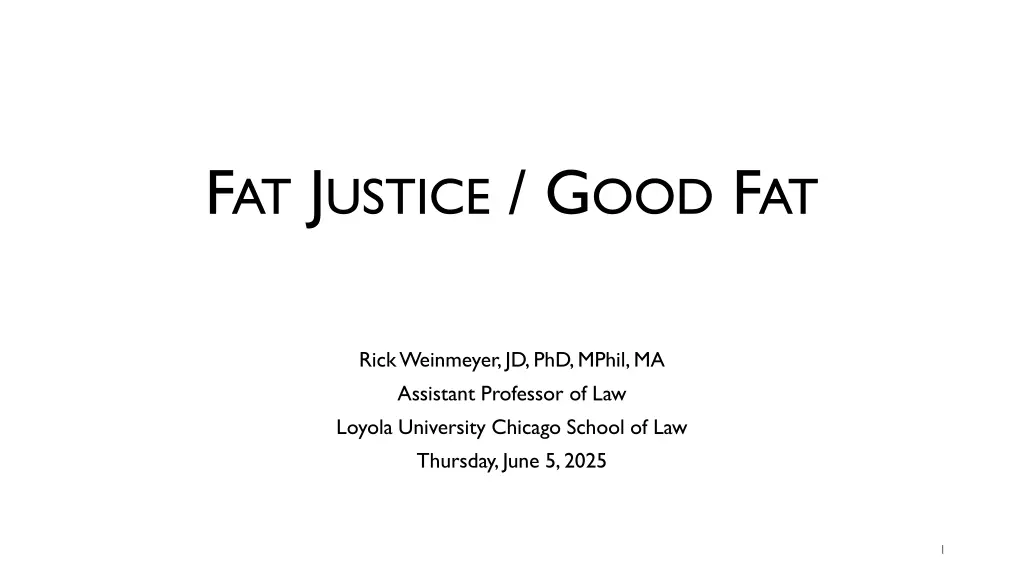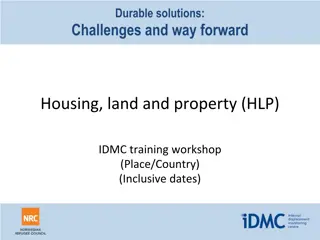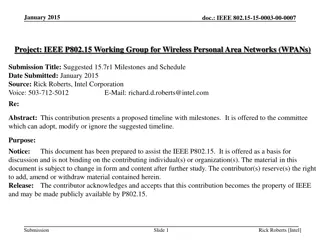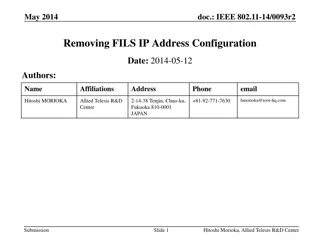
Understanding Fat Justice and Public Health Implications
Explore the concept of Fat Justice, challenging societal norms around body weight, terminology, and discrimination. Learn about GLP-1s, obesity-related public health issues, and the movement towards equitable treatment for individuals of all body sizes.
Download Presentation

Please find below an Image/Link to download the presentation.
The content on the website is provided AS IS for your information and personal use only. It may not be sold, licensed, or shared on other websites without obtaining consent from the author. If you encounter any issues during the download, it is possible that the publisher has removed the file from their server.
You are allowed to download the files provided on this website for personal or commercial use, subject to the condition that they are used lawfully. All files are the property of their respective owners.
The content on the website is provided AS IS for your information and personal use only. It may not be sold, licensed, or shared on other websites without obtaining consent from the author.
E N D
Presentation Transcript
FAT JUSTICE / GOOD FAT Rick Weinmeyer, JD, PhD, MPhil, MA Assistant Professor of Law Loyola University Chicago School of Law Thursday, June 5, 2025 1
OUTLINE 1. Fat Justice 2. GLP-1s, Fat & Public Health 3. Settings 1. Clinical Encounter 2. Anti-Discrimination Protections 2
FAT JUSTICE - TERMINOLOGY Overweight Obese implies that there is an objectively determined correct weight for every body 1 obesus: having eaten oneself fat the deeply problematic medical term [ ] which causes harm to people under the guise of objectivity 2 1AUBREY GORDON, YOU JUST NEEDTO LOSE WEIGHT AND 19 OTHER MYTHSABOUT FAT PEOPLE xix (2023). inherently blame[es] fat people for [their] bodies 1 2Deborah McPhail & Michael Orsini, Fact acceptance as social justice, 193 CAN. MED. ASS N J. e1398 (2021). 3
FAT JUSTICE - TERMINOLOGY Fat [A] neutral descriptor for predominately plus-size people. . . . [M]any fat people . . . reclaim the term as an objective adjective to describe our bodies, like tall or short. Fat hasn t become a bad word because fatness is somehow inherently undesirable but because of what we attach to it. AUBREY GORDON, YOU JUST NEEDTO LOSE WEIGHT AND 19 OTHER MYTHSABOUT FAT PEOPLE xviii (2023). 4
FAT JUSTICE THEORY / MOVEMENT Aubrey Gordon & Lindy West 5
FAT JUSTICE THEORY / MOVEMENT [W]e live in a world in which fat people face staggering disparities in employment, healthcare, accessibility, and then insists those disparities are our own fault for failing to achieve and maintain thin bodies. . . . [W]e are too often told that these systematic problems are a result of our individual decisions. If we were just thin, we wouldn t experience all of this. Fat justice requires those who are not fat to hear and understand the experiences of fat people, and to build a world that doesn t assume fat people are failed thin people or that thin people are categorically healthy and virtuous. . . . a world in which fat bodies are valued and supported just as much as thin ones. AUBREY GORDON, WHAT WE DON T TALK ABOUT WHEN WE TALK ABOUT FAT 8, 161 62 (2020). 6
GLP-1S, FAT & PUBLIC HEALTH Public Health Many serious chronic diseases associated with obesity 58% of U.S. adults with obesity have high blood pressure. Approximately 23% of U.S. adults with obesity have diabetes. Obesity accounts for nearly $173 billion in medical expenditures in 2019 dollars. But . . . Ecological fallacy: Everyone who is obese is unhealthy. Adult Obesity Facts, CTRS. FOR DISEASE CONTROL & PREVENTION(May 14, 2024). 7
GLP-1S, FAT & PUBLIC HEALTH Benefits of GLP-1s Side Effects & Challenges A1C Blood pressure Lipid disorders Fatty liver disease Heart disease and chronic kidney disease Cancer risk Health: nausea, constipation, diarrhea, vomiting, loss of appetite, etc. Social / behavioral: Reduced enjoyment of food Changes to relationships Stigma of [not] taking medication Adherence Misuse Changes to diet and physical activity 8
GLP-1S, FAT & PUBLIC HEALTH GLP-1s and biological complexity of weight-health relationship: BMI Flawed and tied to specific health harms Fat = Unhealthy Body size/weight is only one factor in health Weight Equilibrium Set Point Theory = idea that a person's weight set point is established early in life and remains relatively stable unless altered by specific conditions 9
CLINICAL ENCOUNTER A common provider stereotype about fat patients is that they are less likely to be adherent to treatment or self-care recommendations, are lazy, undisciplined and weak-willed. Primary care providers have reported less respect for fat patients compared with those who are straight size, and low respect has been shown to predict less positive affective communication and information giving. You know, I love Lizzo. But it s a shame that this whole body-positivity movement has made so many people think that it s O.K. to be obese. Physician Primary health care providers may allocate time differently, spending less time educating fat patients about their health. Physicians may over-attribute symptoms and problems to body size, and fail to refer the patient for diagnostic testing or to consider treatment options beyond advising the patient to lose weight. Jia Tolentino, Will the Ozempic Era Change How We Think About Being Fat and Being Thin?, NEW YORKER (Mar. 20, 2023) (quoting a physician during a discussion of Ozempic). S.M. Phelan et al., Impact of weight bias and stigma on quality of care and outcomes for patients with obesity, 16 OBESITY REVS. 319, 321 (2015). 10
CLINICAL ENCOUNTER Health Equality [H]uman beings possess dignity and that dignity is priceless. . . . Treating a person or group of people worse than their peers offends their dignity by ignoring their inherent value. Thus, acting based on animus or stigma denies our human dignity and is un- egalitarian. JESSICA L. ROBERTS & ELIZABETH WEEKS, HEALTHISM: HEALTH- STATUS DISCRIMINATIONANDTHE LAW 37 (2018). 11
CLINICAL ENCOUNTER Medical Malpractice Ignoring pressing health issue(s) and focusing on weight IIED Bullying patients to lose weight / use GLP-1s Other Patient Harms Seeking out GLP-1 alternatives (e.g., compounded versions) 12
ANTI-DISCRIMINATION PROTECTIONS Jurisdictions with Protections Against Weight Discrimination Although obese people report discrimination in places of employment, privately owned accommodations and public services, research shows that the area of employment warrants particular attention. . . . Studies confirm that obese persons are less likely to be hired, are more harshly disciplined, paid less, and have been terminated for failure to lose weight. 1 State: Michigan Cities: Binghamton, N.Y.; Madison, W.I.; Miami Beach, Fl.; San Francisco, C.A.; Santa Cruz, C.A.; Urbana, Il.; New York, N.Y.; Washington, D.C. One broad-sweeping solution could be that antidiscrimination law move away from the protected- class-based framework and instead focus on universal rights and liberties that ought to be enjoyed by all. 2 Courts have largely resisted extending disability protections to plaintiffs under the ADA. 1Jennifer L. Pomeranz, A Historical Analysis of Public Health, the Law, and Stigmatized Social Groups: The Need for Both Obesity and Weight Bias Legislation, 16 OBESITY S93, S99 (2008). 2Valarie K. Blake & Mark L. Hatzenbuehler, Legal Remedies to Address Stigma-Based Health Inequalities in the United States: Challenges and Opportunities, 97 MILBANK Q. 480, 498 (2019). 13
ANTI-DISCRIMINATION PROTECTIONS The intuition is that weight discrimination is unfair only if a plaintiff's weight is a function of her biology and a result of chance, not choice. . . . Perhaps sensing a problem with the harshness, intrusiveness, and stigmatizing nature of a rule requiring a plaintiff to provide expert medical testimony showing she is not to blame for her weight, judges do not always state the premise of the physiological cause requirement explicitly. Rather, they grope for other arguments to explain their results. 1 Yet obesity is a condition that is regarded as both inessential and stigmatized, falling through the cracks of the revised immutability. Body weight seems an unlikely candidate for inclusion in a list of traits thought central, fundamental, or integral to identity. Those seeking to lose weight are particularly unlikely to advocate for this characterization. 2 1Jessica A. Clarke, Against Immutability, 125 YALE L.J. 2, 56 57 (2015). 2Id. at 60 61. 14
ANTI-DISCRIMINATION PROTECTIONS The Right To Be Fat Role of Dignity The human experience of body size is imbued with meaning beyond what the medical, instrumentalist, and scientific paradigms can capture. These meanings stem from domains as intimate and intricate as emotions, culture, identity, and personhood. . . . [The right to be fat] derives from the right to liberty and is a concrete instance of the rights to autonomy and human dignity. Another question of mutability = homelessness, poverty The fundamental right articulated by Lawrence is grounded in a respect for individual self-definition or self- governance and centered on intimate personal choices. This right, though framed by reference to the Constitution s invocation of liberty, more closely tracks contemporary definitions of human dignity. The right to be fat is the right to be free of governmental (and sometimes societal) intervention regarding one s weight, either by direct treatment or indirect impact. It also means being equally entitled to social goods regardless of one s physical weight. The dignity analysis of Lawrence thus casts inequality concerns as a matter of substantive subordination, rather than formal equality. It also emphasizes the distinctive harms of lending an official imprimatur to existing social dislike for marginalized groups[.] Yofi Tirosh, The Right to Be Fat, 12 YALE J. HEALTH POL Y L. & ETHICS 264, 313 (2012). Ben A. McJunkin, The Negative Right to Shelter, 111 CALIF. L. REV. 127, 178, 180 (2023). 15
Thank you! Email: rweinmeyer@luc.edu Bluesky: rickweinmeyer.bsky.social 16






















